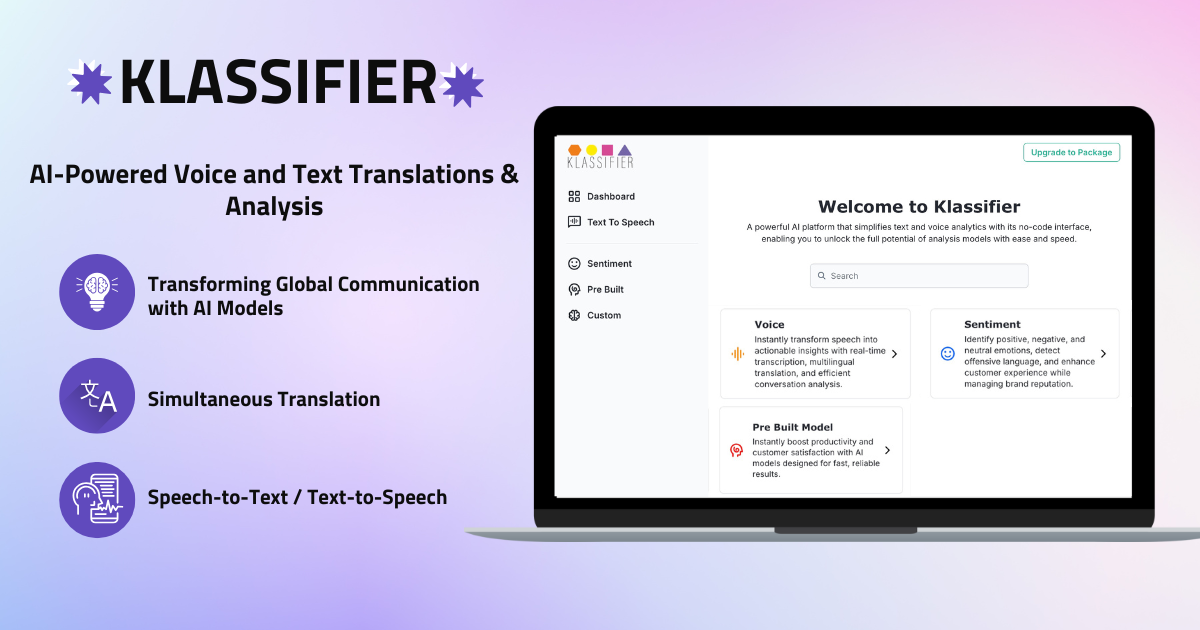Table of Contents
Overview
In today’s increasingly globalized world, effective communication across language barriers is paramount. Klassifier emerges as a powerful AI-driven solution, offering real-time speech and text translation capabilities. This platform aims to bridge linguistic divides, fostering accessibility and inclusivity in various international settings. Let’s dive into a comprehensive review of Klassifier and explore how it can revolutionize your multilingual communication.
Key Features
Klassifier boasts a suite of features designed to facilitate seamless communication across languages:
- Real-time speech translation: Klassifier instantly translates spoken words, enabling natural conversations in multilingual environments.
- Text translation: The platform also supports text translation, allowing users to communicate effectively in written form across different languages.
- Multilingual support: Klassifier supports a wide array of languages, catering to diverse communication needs.
- Accessibility enhancement: By providing real-time translation, Klassifier enhances accessibility for individuals who speak different languages, promoting inclusivity in global interactions.
- AI-driven communication tools: Klassifier leverages artificial intelligence to deliver accurate and efficient translations, ensuring effective communication.
How It Works
Klassifier simplifies the translation process with its intuitive platform. Users connect to the platform, where speech or text inputs are processed by AI algorithms. These algorithms then generate immediate translations in the desired target languages. This real-time processing allows for seamless and natural communication, breaking down language barriers in real-time.
Use Cases
Klassifier’s versatility makes it suitable for a wide range of applications:
- Multilingual meetings: Facilitate productive discussions with participants who speak different languages, ensuring everyone can understand and contribute effectively.
- International conferences: Enable attendees from around the world to engage with presentations and discussions in their native languages.
- Education and webinars: Deliver educational content to a global audience, making learning accessible to students from diverse linguistic backgrounds.
- Inclusive corporate communication: Foster a more inclusive workplace by providing real-time translation for internal communications, ensuring all employees can stay informed and engaged.
Pros & Cons
Like any tool, Klassifier has its strengths and weaknesses. Let’s examine the advantages and disadvantages of using this platform.
Advantages
- Supports real-time translation, enabling immediate communication.
- Improves accessibility for individuals who speak different languages.
- Easy to deploy and integrate into existing workflows.
Disadvantages
- Translation quality may vary depending on accents or noisy environments.
- Dependent on a stable internet connection for optimal performance.
How Does It Compare?
When considering real-time translation solutions, it’s important to compare Klassifier with its competitors.
- Interprefy: Interprefy offers similar real-time translation services, primarily focusing on events and conferences. While powerful, it can be a more complex and expensive solution compared to Klassifier.
- Google Meet Translate: Google Meet’s built-in translation feature provides a convenient option for meetings within the Google ecosystem. However, it offers limited control and customization compared to Klassifier’s dedicated platform.
Final Thoughts
Klassifier presents a compelling solution for organizations and individuals seeking to overcome language barriers and foster effective communication in multilingual settings. While factors like internet connectivity and environmental noise can impact translation quality, the platform’s real-time capabilities and ease of use make it a valuable tool for promoting accessibility and inclusivity in an increasingly interconnected world.
https://klassifier.com